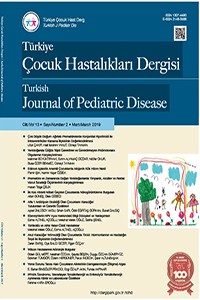Abstract
TORTİKOLLİS VE ALTTA YATAN CİDDİ
HASTALIKLAR
Giriş: Tortikollis,
boynun rotasyonel deformitesine bağlı başın bir yana eğilmesi ile karakterize
bir klinik bulgudur. Konjenital olarak meydana gelebileceği gibi birçok altta
yatan basit veya ciddi hastalık tortikollise neden olabilir. Bu çalışmadaki
amaçlarımız, tortikollis tanısı almış hastaların konjenital ve edinsel
dağılımlarını ortaya çıkartmak ve özellikle edinsel tortikollis saptanan
hastalarda altta yatan nedenleri belirleyip olayın ciddiyeti ile ilgili uyarıcı
semptomları saptamaktır.
Gereç ve Yöntemler:
Ocak 2011-Kasım 2018 tarihleri arasında hastanemiz genel pediatri
polikliniklerine başvuran ve tortikollis tanısı alan çocuk hastaların hastane
kayıtları incelendi. Hastaların demografik verileri, başvuru
semptomları, fizik inceleme bulguları, laboratuvar ve radyolojik verileri
kaydedildi.
Bulgular:
Tortikollis nedeni ile başvuran toplam 532 hasta vardı. Bu hastaların %44,3’ü
(n=232) edinsel tortikollis grubunda idi. En sık edinsel tortikollis nedenleri enfeksiyonlar
(%29,3) ve postural tortikollis (%13,2) idi. Dokuz hastada ise daha nadir
nedenlere bağlı tortikollis geliştiği görüldü. Bu nadir nedenler sırası ile
Grisel sendromu (n=5), şaşılık (n=2), Sandifer sendromu (sitrülinemiye bağlı)
(n=1) ve lösemi (n=1) idi. Kusma (OR:23,1[13,6-42,1]), ateş (OR:5,1 [2,6-7,8])
ve yutma güçlüğü (OR: 19,6 [7,2-32,5]) semptomlarının hastalık ciddiyetini
belirlemede istatistiksel olarak anlamlı risk faktörleri olduğu saptandı.
Tartışma: Tortikollis
altta yatan birçok hastalığın bulgusu olarak karşımıza çıkabilir. Kusma, ateş
ve yutma güçlüğü semptomlarının varlığı tortikollis ile başvuran çocuk
hastalarda altta yatan ciddi bir hastalık için uyarıcı olabilir. Ayrıntılı öykü
ve özenli bir sistemik muayene yapılması konjenital ve edinsel tortikolliste
prognoza oldukça önemli katkı sağlayacaktır.
References
- Cheng J, Au A. Infantile torticollis: a review of 624 cases. Journal of pediatric orthopedics. 1994;14:802-8.
- Güven A, Çalışkan B, Atabek C, Karakaya E, Demirağ S, Sürer İ. Konjenital müsküler tortikollisde pasif germe egzersizlerinin etkinliği. Gülhane Tıp Dergisi. 2008;50:98-101.
- Haque S, Bilal Shafi BB, Kaleem M. Imaging of torticollis in children. Radiographics. 2012;32:557-71.
- Tomczak KK, Rosman NP. Torticollis. Journal of child neurology. 2013;28:365-78.
- Herman M. Torticollis in infants and children: common and unusual causes. Instructional course lectures. 2006;55:647-53.
- Brauer S. Congenital muscular torticollis. Journal of physiotherapy. 2015;61:164.
- Pharisa C, Lutz N, Roback MG, Gehri M. Neck complaints in the pediatric emergency department: a consecutive case series of 170 children. Pediatric emergency care. 2009;25:823-6.
- Blankstein A, Pavlotsky F, Roizin H, Ganel A, Chechick A. Acquired torticollis in hospitalized children. Harefuah. 1997;133:616-9, 63.
- Dyer T, Dancey P, Martin J, Shah S. Torticollis as Presentation for Atypical Kawasaki Disease Complicated by Giant Coronary Artery Aneurysms. Case reports in pediatrics. 2018;2018:4236264.
- Croche BS, Prieto ADP, Madrid MC, Neth O, Obando IS, editors. Retropharyngeal and parapharyngeal abscess: experience in a tertiary-care center in Seville during the last decade. An Pediatr (Barc). 2011;75:266-72.
- Iaccarino C, Francesca O, Piero S, Monica R, Armando R, de Bonis P et al. Grisel's Syndrome: Non-traumatic Atlantoaxial Rotatory Subluxation-Report of Five Cases and Review of the Literature. Acta Neurochir Suppl. 2019;125:279-288.
- Viscone A, Brembilla C, Gotti G. The importance and effectiveness of conservative treatment in Grisel's syndrome. Journal of pediatric neurosciences. 2014;9:200.
- Moore DM, Rizzolo D. Sandifer syndrome. Journal of the American Academy of PAs. 2018;31:18-22.
- Siegenthaler MH. Chiropractic management of infantile torticollis with associated abnormal fixation of one eye: a case report. Journal of chiropractic medicine. 2015;14:51-6.
Details
| Primary Language | Turkish |
|---|---|
| Subjects | Internal Diseases |
| Journal Section | ORIGINAL ARTICLES |
| Authors | |
| Publication Date | March 26, 2019 |
| Submission Date | January 22, 2019 |
| Published in Issue | Year 2019 Volume: 13 Issue: 2 |
Cite
The publication language of Turkish Journal of Pediatric Disease is English.
Manuscripts submitted to the Turkish Journal of Pediatric Disease will go through a double-blind peer-review process. Each submission will be reviewed by at least two external, independent peer reviewers who are experts in the field, in order to ensure an unbiased evaluation process. The editorial board will invite an external and independent editor to manage the evaluation processes of manuscripts submitted by editors or by the editorial board members of the journal. The Editor in Chief is the final authority in the decision-making process for all submissions. Articles accepted for publication in the Turkish Journal of Pediatrics are put in the order of publication taking into account the acceptance dates. If the articles sent to the reviewers for evaluation are assessed as a senior for publication by the reviewers, the section editor and the editor considering all aspects (originality, high scientific quality and citation potential), it receives publication priority in addition to the articles assigned for the next issue.
The aim of the Turkish Journal of Pediatrics is to publish high-quality original research articles that will contribute to the international literature in the field of general pediatric health and diseases and its sub-branches. It also publishes editorial opinions, letters to the editor, reviews, case reports, book reviews, comments on previously published articles, meeting and conference proceedings, announcements, and biography. In addition to the field of child health and diseases, the journal also includes articles prepared in fields such as surgery, dentistry, public health, nutrition and dietetics, social services, human genetics, basic sciences, psychology, psychiatry, educational sciences, sociology and nursing, provided that they are related to this field. can be published.

